This information has been
reprinted from a 1912 Popular Mechanics publication
titled "Mission Furniture And How To Make It".
Extendable Table
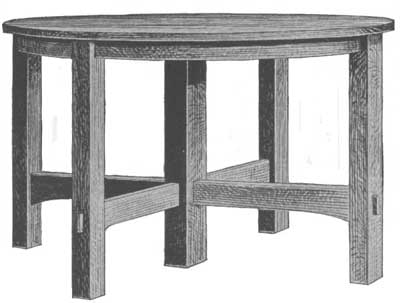
This extension table should
be made of some hard wood, preferably white oak. It will
be a difficult matter to secure legs of the sizes
indicated in solid pieces of clear stock. It will be
possible, however, to secure them veneered upon
white-pine cores. If the veneering is properly done
these will serve the purpose very well, the lighter
weight, due to the white-pine core, being an advantage.
The circular facing is best made by first sawing a
segment of the circle of the size wanted and then
veneering the outer surface of this. Order the following
stock:
- 4 legs, 3 by 3 by 30-1/2
in., S-4-S.
- 1 leg, 5 by 5 by 30-1/2
in., S-4-S.
- 4 rails, 1-1/8 by 5 by 23
in., S-2-S.
- 4 facing segments, 1-1/8
by 3-1/4 in. on a 24-in. radius.
- 1 top, 1-1/8 in. thick on
a 27-in. radius, S-2-S;
- 3 extra boards, 1-1/8 by
12 by 55 in., S-2-S.
- 4 slides, 1-1/8 by 2-3/4
by 36-1/2 in., S-4-S, maple.
- 2 slides, 1-1/4 by 2-3/4
by 36-1/2 in., S-4-S, maple.
- 4 frame pieces, 7/8 by 3
by 9 in., S-4-S, maple.
- 2 frame pieces, 7/8 by 6
by 28 in., S-4-S, maple.
- 2 frame pieces, 7/8 by 4
by 23-1/2 in., S-4-S, maple.
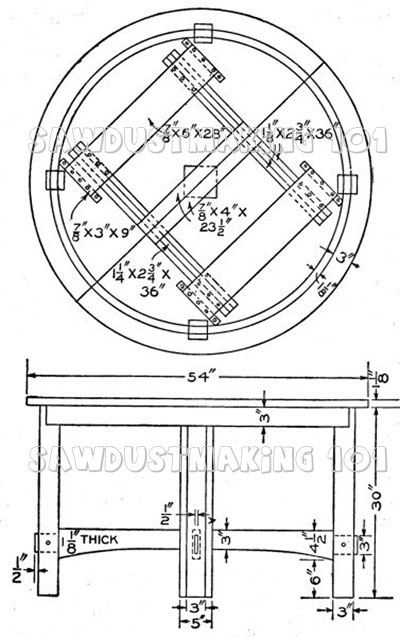
There are various ways of
arranging the slides to work one with the other. Several
patented devices are on the market that permit a ready
adjustment with but little effort and are used
extensively by commercial manufacturers. The amateur
will do well to secure a set before he undertakes to
work these slides to shape.
| Equalizer
Slides |
| Super
easy one handed extension. As you pull on one
half, the other side moves away.
Equalizer
Slides
|
 |
Prepare the legs by cutting
them to length. Lay out and work the mortises. The ends
of the facings are to be tenoned and housed into the
posts. Prepare the rails by cutting the tenons and
shaping the lower edges as shown in the drawing. Prepare
the top. After this, assemble this much of the frame,
using plenty of clamps and good hot glue.
Next get the under frame and
the slides ready and attach them as shown. There will be
needed plenty of glue blocks for reinforcing the facing
where it is fastened to the top, etc.
For a finish, apply a filler
colored, as desired. Upon this, after it has hardened
and been sanded with No. 00 paper, apply a coat of
shellac. Upon the shellac apply successively several
coats of some good rubbing varnish. Rub the first coats
with haircloth and the final coat with pulverized pumice
and crude or linseed oil.
If an effect is wanted that
will contrast, stain the wood first with a water stain.
Sand this lightly when dry, then apply a second coat of
stain diluted one-half with water. Again sand and then
apply a thin coat of shellac. Sand this lightly, and
apply the filler and the varnish as described above.
 |
Table
Pins
Align
tops with Table Pins..
Table
Pins
|
 |
Align-N-Lock
Performs
both functions simultaneously...
Align-N-Lock
|
Arm Dining Chair
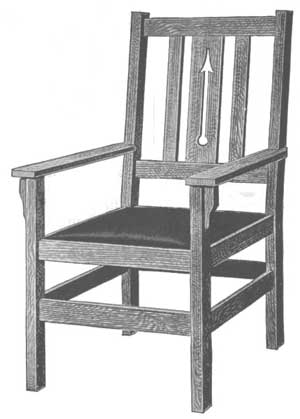
This armchair will look well
if made of plain-sawed oak. Quarter-sawed oak might be
used, or black walnut if desired. The stock bill
specifies the various parts mill-planed to size as far
as possible. If some amateur craftsman should prefer to
[80]do his own surfacing,
thereby saving somewhat on the expense, he should add
1/4 in. to the width of each piece, providing the stock
is mill-planed to thickness. It is hardly profitable to
get stock entirely in the rough if the work is to be
done by hand. The following is the stock bill:
- 2 front posts, 1-3/4 by
1-3/4 by 25 in., S-4-S.
- 1 piece for back posts,
1-3/4 by 6 by 43 in., S-2-S.
- 2 arm pieces, 7/8 by 4 by
24-1/2 in., S-4-S.
- 2 seat rails, 1 by 2-1/2
by 22 in., S-4-S.
- 2 seat rails, 1 by 2-1/2
by 24 in., S-4-S.
- 4 lower side rails, 5/8 by
1-1/2 by 22 in., S-4-S.
- 2 front and back lower
rails, 5/8 by 2-3/4 by 24 in., S-4-S.
- 1 back rail, 3/4 by 2-1/4
by 24 in., S-4-S.
- 1 back rail, 3/4 by 2-1/2
by 24 in., S-4-S.
- 2 slats, 3/8 by 2 by
16-1/2 in., S-4-S.
- 1 slat, 3/8 by 4-1/2 by
16-1/2 in., S-4-S.
- 2 braces, 7/8 by 2-1/2 by
5-1/2 in., S-2-S.
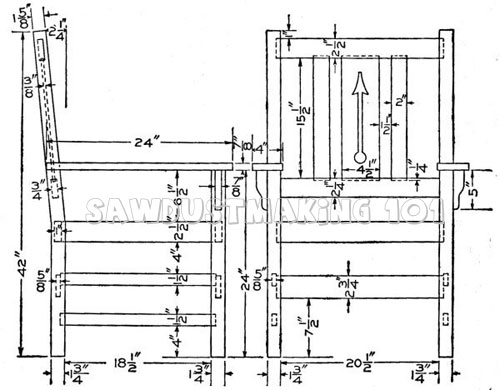
The design shown is for a
chair in which the width of front and back is the same.
Also the back leg parallels the front below the seat. In
commercial practice the backs are usually made somewhat
narrower than the fronts and the back leg is slanted
somewhat below the seat as well as above. As this
construction necessitates sloping shoulders on all
tenons it complicates the problem when the work is not
done by machinery. The ambitious amateur may readily get
the proportion of slant by measuring common chairs. For
mission effects the chair looks well with front and back
the same width.
Prepare the front posts first
and then the rear. The rear posts are to be cut from the
single piece of stock specified. By proper planning both
pieces may be gotten out without trouble. Lay off and
cut the mortises.
Saw the rails to length and
lay out and cut the tenons. The back rails are to have
mortises in their edges to receive the ends of the
slats. Instead of [81]
tenoning these slats make mortises large enough to
receive the whole end—in other words, house the ends.
Shape the two arms, then glue
up the back and then the front of the chair. After the
glue has set sufficiently, assemble the remainder of the
parts.
Thoroughly scrape and
sandpaper the parts and then apply the finish.
For a seat, either a leather
cushion may be placed upon slats or the bottom may be
upholstered in the usual manner, using webbing on heavy
canvas, and then felt or hair with a top of canvas and
leather; the whole being firmly fastened with tacks and
the leather with ornamental nails.
Side Chair

A companion piece to the
chair with arms and the sideboard is the side chair
illustrated herewith. It should be made of the same kind
of wood and finished to correspond with the armchair.
Order the following stock list:
- 2 front posts, 1-1/2 by
1-1/2 by 18-1/2 in., S-4-S.
- 1 piece for back posts,
1-1/2 by 5-1/2 by 38-1/2 in., S-2-S.
- 4 seat rails, 1 by 2 by 17
in., S-4-S.
- 4 lower side rails, 5/8 by
1-1/4 by 17 in., S-4-S.
- 2 lower front and back
rails, 5/8 by 2-1/2 by 17 in., S-4-S.
- 1 back rail, 3/4 by 2-1/4
by 17 in., S-4-S.
- 1 back rail, 3/4 by 2 by
17 in., S-4-S.
- 1 slat, 3/8 by 3 by 13-1/2
in., S-4-S.
- 2 slats, 3/8 by 1-1/2 by
13-1/2 in., S-4-S.
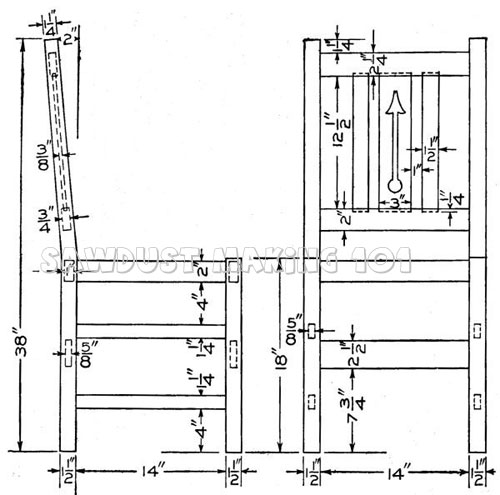
Square up the front posts to
length. From the single piece specified cut out the back
posts, giving them the amount of slant indicated in the
drawing. Set these four posts upright in the positions
they are to occupy relative to one another in the
finished piece, and mark off, as with penciled circles,
the approximate locations of mortises. After this, lay
them on the bench side by side, even the lower ends and
locate accurately the ends of the mortises. Gauge their
sides.
Saw the rails to length and
lay out the shoulder lines and the cheeks of the tenons
and cut them. Plan to house the ends of the slats in the
back rails.
While the drawing shows a
chair in which the front and back are of equal width,
the amateur may make the back narrower if he so desires.
A measurement of a common chair will give the
proportions.
Place the front and the back
in the clamps and after the glue has had time to harden,
assemble the remaining parts. Thoroughly scrape and
sandpaper all the parts, carefully removing any surplus
glue. Wood finish will not "take hold" where any glue
has been allowed to remain.
The seat may be given the
same treatment as suggested for the armchair. This
should not be done, however, until the finish has been
applied.
A simple finish is obtained
by the application of a coat of paste filler of a soft
brown color, if oak has been used. Apply and clean this
off in the manner directed by the manufacturers and
after it has had 24 hours in which to harden, sand it
lightly with No. 00 paper. Over this apply a thin coat
of shellac. Allow this to harden, then sandpaper lightly
with fine paper. Upon the shellac apply several coats of
some good rubbing wax. Follow the directions that are to
be found upon the cans, being careful not to apply too
much at a time. If too much wax is applied, it stays in
the small pores of the wood and produces an ugly
chalk-like appearance.
|

